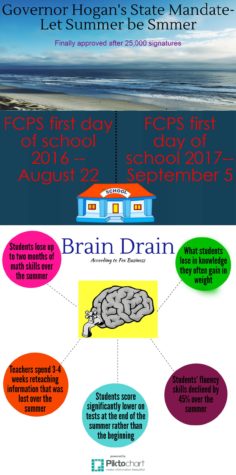School’s out until Labor Day: What’s bad about a longer summer?
September 26, 2016
 On August 31, 2016 Governor Larry Hogan signed an executive order that mandates that schools must start after Labor Day and end before June 15, while still getting the required 180 days of school. This was after a petition, “Let Summer be Summer“sponsored by Comptroller Peter Franchot, received 25,000 signatures in support of the longer summer and after battles in the Maryland House and Senate.
On August 31, 2016 Governor Larry Hogan signed an executive order that mandates that schools must start after Labor Day and end before June 15, while still getting the required 180 days of school. This was after a petition, “Let Summer be Summer“sponsored by Comptroller Peter Franchot, received 25,000 signatures in support of the longer summer and after battles in the Maryland House and Senate.
Although Franchot has been a major supporter of starting school after Labor Day, after the mandate goes into effect, his department will no longer deal with the repercussions.
There is a catch to the new executive order, though. School systems can get out of starting after Labor Day by applying for a waiver through the Maryland State Department of Education.
Tiana Hill, FCPS Community Engagement Coordinator, said, “Once the Maryland State Department of Education determines the criteria for the waiver, Frederick County Public Schools Board of Education will determine whether we want to move forward with the application to be exempt from the mandate.”
Some parents believe that this is just going back to the old days. Former Montgomery County teacher, Jim Brown said, “I don’t know why some people are up in arms about this? They did this in the old days and it seemed to work great.”
According to Forbes, approximately 25% of American schools start after Labor Day. Neighbor state, Virginia, starts after Labor Day because of the “Kings Dominion Law.” Maryland has officially joined one of the few states that makes it mandatory to start after Labor Day. These states include: Ohio, Pennsylvania, Minnesota, and Michigan.
After Hogan made his declaration, Mayor Rick Meehan, of Ocean City, said in the press conference, “I am thrilled to see an executive order to start school after Labor Day, not because it is good for Ocean City, but because it’s good for the entire state.”
The Maryland Association of Board of Educators opposes this decision. They released a statement that said, “MABE strongly opposes this initiative as contrary to the principle of local governance, and the traditional role of boards of education and their communities in setting school calendars. The strict limitation of ending school on June 15th will require not only new school calendars but new teacher and employee contracts. The time and money spent on these negotiations would be better spent on educating our 870,000 public school students.”
Local teachers are asking questions like, “What will happen with dual enrollment, since FCC classes start well before Labor Day.”
Hogan is hoping that starting after Labor Day will help attract tourism which will help the economy. With the extra few weeks of summer, Hogan hopes more families will be taking more vacations to Ocean City and other Maryland destinations.
Hogan said in his speech, “This will directly help the economy by generating an additional $74.3 million in direct economic activity, including $3.7 million in new wages and $7.7 million in state and local tax revenue.”
But, this might not be easy for lower income families. Maryland families can’t always afford the beach. According to Lancer Media’s calculations, To stay at the Hilton in Ocean City for one week in the lowest price room it would cost $2,191 for the week and $313 for a night.
During these two extra weeks of summer, families will most likely rely on daycare to take care of their children. At Celebree, the average cost for one school-aged child to be in their program is $200 a week. If a working parent with two children has to pay child care for a week it could be $400 a week. Finding daycare for two additional weeks is another hardship.
During the 2015-2016 school year, 46% of students were on Free and Reduced meals in Maryland. This means that 46% of students would be going two more weeks in the year without food, and families would be struggling to make ends meet.
In the 2016-2017 school year, students have 25 days off including winter and spring break. Next year, with the new change students should expect a drastic decrease. Counting all of the mandatory days in the smaller window, there will only be 11 days off of school, including spring and winter break. Try planning a calendar yourself using The Baltimore Sun‘s interactive calendar.
Maryland has officially let summer be summer. Now, we will see who gets burned.





